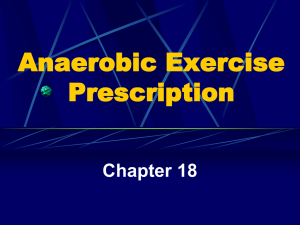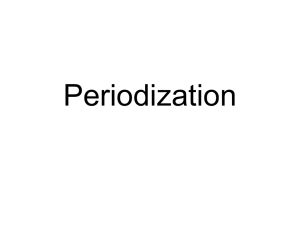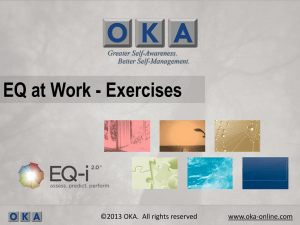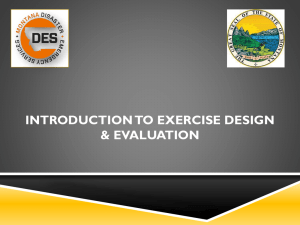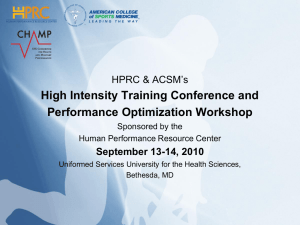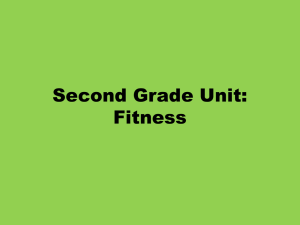Resistance Exercise Prescription
advertisement
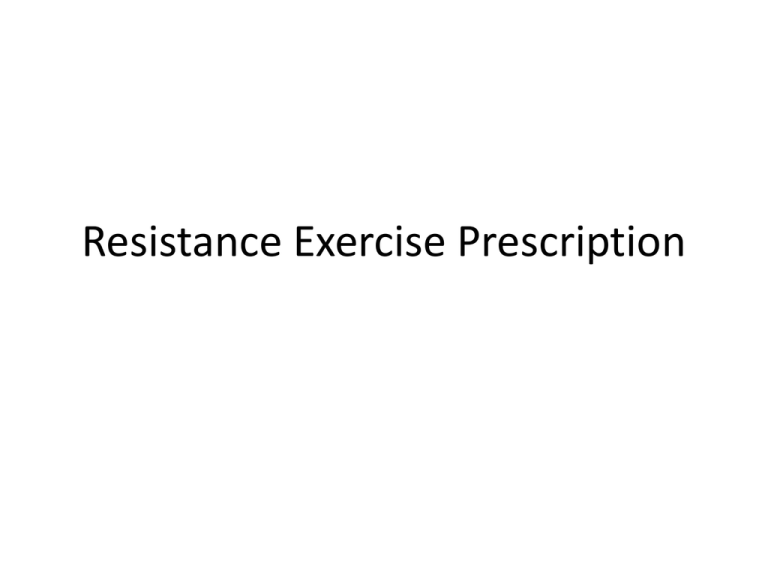
Resistance Exercise Prescription Designing RE Prescriptions • Acute Variables: – – – – – Choice of exercises Order of exercises Exercise intensity Exercise volume Inter-set rest intervals • Chronic Variables: – Exercise frequency – Progression /Periodization (discussed later in course) 2 Choice of Exercises • Choose exercises that target primary muscle groups of sport (performance), and promote balance/symmetry (injury prevention) • Machines vs. free weight exercises – Machines are easier to learn and less intimidating – Free weights might give better “performance” results. Also less costly. • Multi-joint vs. single-joint exercises – Recommendation: rely primarily on multi-joint • Muscle actions – Recommendation: for optimal gains in muscle strength and size exercises must include eccentric muscle actions 3 Order of Exercises • Place most important exercises first – If the client needs to increase lower-body strength, then place lower-body exercises first in the workout • ACSM Position Stand: – “Power” exercises performed before “strength” exercises • E.g., power clean before squat – Large muscle group exercises performed before small muscle group exercises • E.g., squat before calf raise – Multi-joint exercises before single-joint exercises • E.g., squat before knee extension 4 Exercise Volume and Intensity • Volume = Exercises x Sets x Repetitions • Intensity = Resistance (Load) • Methods of prescribing volume and intensity: 1. 2. 3. 4. X repetitions at Y% 1-RM X-RM X repetitions at Y RPE X repetitions using a load based on analysis of training logs 5 Prescribing Volume and Intensity • The best strength coaches individualize training for athletes – Requires logging workout performances (preferably electronically) – Requires analyzing training logs • For the purposes of this class, we will utilize the X-RM method 6 Exercise Volume & Intensity Strength/Power Hypertrophy 1 6 8 12 Local Endurance 15 25 Number of Repetitions 7 Exercise Volume and Intensity • ACSM Position Stand (Volume): – Novice: 1-3 sets per exercise – Experienced: Multiple sets • ACSM Position Stand (Intensity): – Novice: 60-70% of 1RM; or 8-12RM – Advanced: 80-100% of 1RM; or 1-6RM 8 Rest Intervals • If goal is strength/power, then rest ~2-3 min between sets – Strength/power gains will be attenuated if rest intervals are too short – For assistance exercises, 1-2 min should suffice • If goal is muscular endurance, then rest ≤ 1 min between sets 9 Exercise Frequency • Frequency = # of sessions per week • ACSM Position Stand: – Novice: 2-3 days/week (appropriate for most people) – Intermediate: 3-4 days/week – Advanced: 4-7 days/week • Remember: you get stronger between work-outs, not during – Importance of recovery 10 Periodization Volume Intensity Off-season Pre-Season In-Season Post-Season 11 Objectives • Overview the physiological basis of periodization • Define key terms related to periodization • Introduce basic concepts of periodized exercise prescriptions 12 Physiological Basis of Periodization • The body’s response to “stress” (exercise) is described by the General Adaptation Syndrome (GAS) and Supercompensation (SC) Theory • GAS and SC are similar methods used to describe the same process: responses and adaptation to stress 13 General Adaptation Syndrome (GAS) 14 Supercompensation (SC) Theory 15 Applying GAS/SC to S&C • A scientifically based exercise prescription can significantly improve performance in a relatively short period of time • Consequences of a training program that is monotonous (doesn’t change over time) or utilizes insufficient recovery: – Plateau in performance (best case scenario) – Decrease in performance – Injury from overuse (worst case scenario) 16 Periodization Terminology • Macrocycle: Typically, a year-long training plan • Phases: 1. 2. 3. 4. Preparatory phase (off-season) Transition phase (pre-season) Competition phase (in-season) Transition phase (post-season) • Mesocycle: A training cycle that addresses specific training goal(s) (e.g., maximizing strength) and usually lasts ~2-8 weeks • Microcycle: Typically, one week of training 17 Periodization • In general, as the athlete progresses from the post-season to the in-season, the training priorities shift from: – Non-specific activities to Sport-specific activities – High-volume/low-intensity to Highintensity/low-volume 18 Off-Season Pre-Season In-Season Post-Season 19
